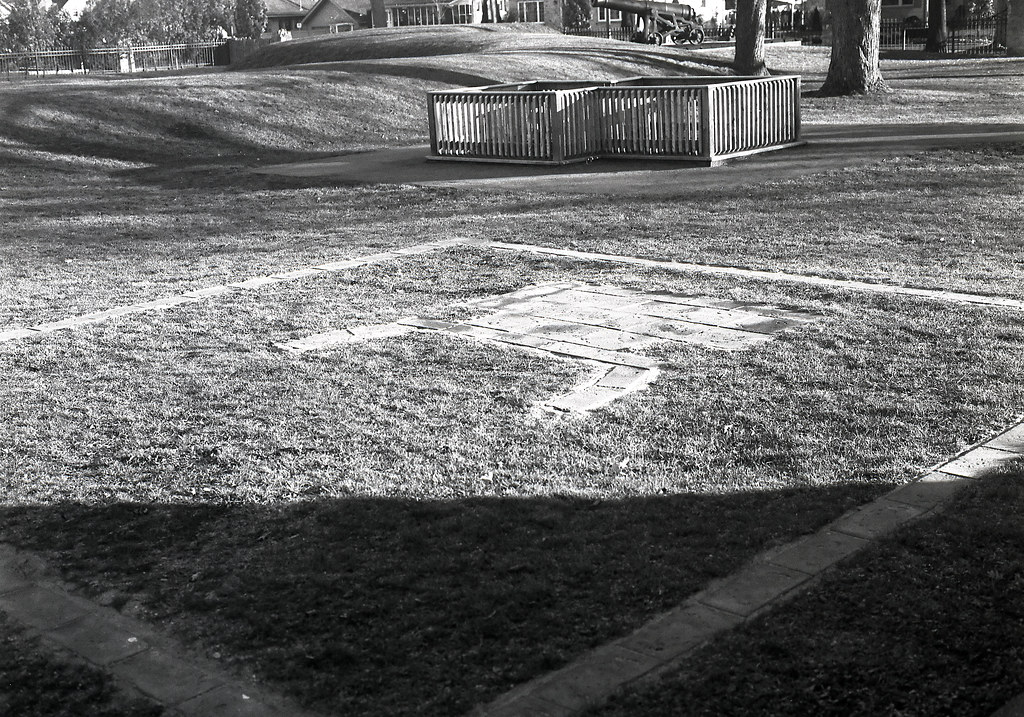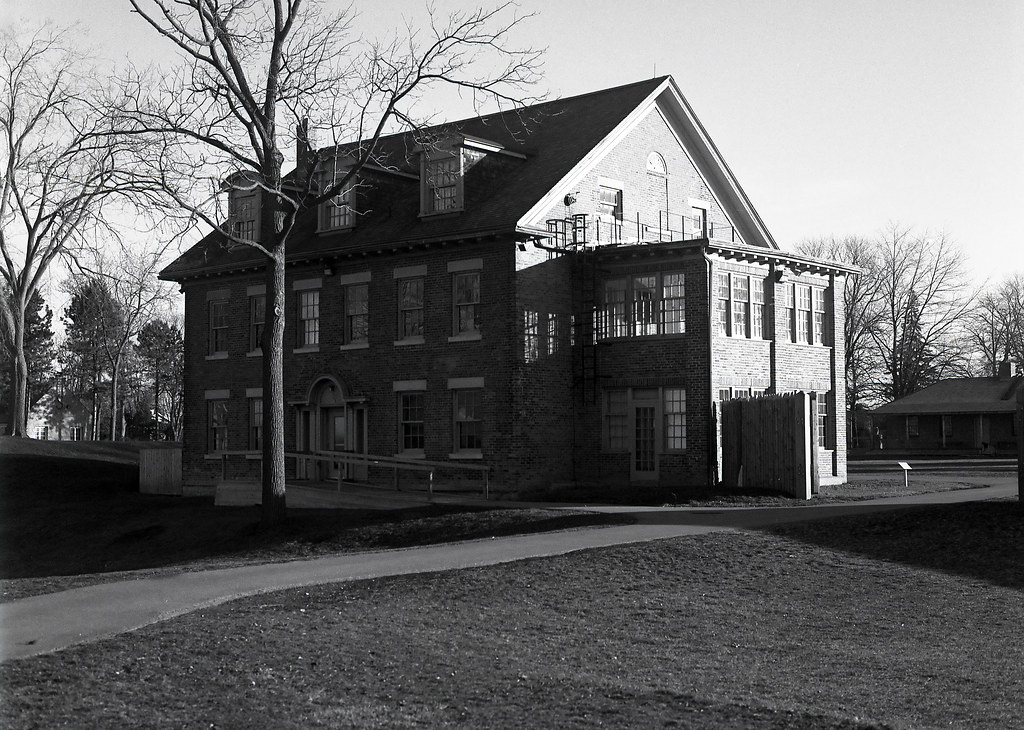If you’ve never heard of Fort Amherstburg or even Fort Malden, I’ll forgive you. Being from the Greater Toronto/Hamilton region of Ontario, much of Western Ontario is a bit of a mystery. It also doesn’t help that today Fort Malden doesn’t look too much like a fort when you compare it to places like Fort York, Fort Erie, and Fort Wellington. Located in the small town of Amherstburg, the fort’s garrison saw some of the heaviest and earliest fightings during the Anglo-American War of 1812 and had a long history beyond that of a military post.

Mamiya m645 – Mamiya-Sekor C 45mm 1:2.8 N – Ilford FP4+ @ ASA-100 – Kodak D-23 (Stock) 6:00 @ 20C
Mamiya m645 – Mamiya-Sekor C 45mm 1:2.8 N – Ilford FP4+ @ ASA-100 – Kodak D-23 (Stock) 6:00 @ 20C
They were initially constructed as Fort Amherstburg following the British withdrawal from Fort Detroit by the 1796 Jay Treaty. Tall earthwork walls mounted artillery batteries, and wooden frame structures provided barracks and quarters for the officers and men. Work on the fort was completed by local labour in the Second Batallion Royal Canadian Volunteers. Colonel George St George of the 41st Regiment of Foot took command, and the men and officers of the 41st provided the garrison. The fort’s purpose was to provide a defence against American ships sailing along the Detroit River and the great upper lakes and the King’s Navy Yard located further south in the small settlement of Amherstburg. The fort also provided a seat for the British Indian Department. While a minor post, the efforts of Major General Sir Isaac Brock in the early 19th century improved the fort’s defences and, most importantly, artillery at the centre.

Pentax 645 – SMC Pentax A 645 35mm 1:3.5 – Kodak Tri-X 400 (400TX) @ ASA-200 – Kodak HC-110 Dil. E 6:30 @ 20C
Pentax 645 – SMC Pentax A 645 35mm 1:3.5 – Kodak Tri-X 400 (400TX) @ ASA-200 – Kodak HC-110 Dil. E 6:30 @ 20C
When the Anglo-American War of 1812 opened in the summer of that same year, Fort Amherstburg found itself on the front line of the new conflict. The garrison at Fort Amerherstburg first learned of the American war plan. The arrival of Tecumseh and the remains of his confederacy and the capture of the Cuyahoga Packet carrying the battle plans for the invasion of Upper Canada and the personal belongings of the American Western Army commander, William Hull. Upon learning that his post would be targeted, Colonel St. George immediately sent word to General Brock for reinforcements. Brock quickly used his position as President of the Executive Council to force the mobilisation of the local Militia and his command of the British Army to direct reinforcements west. Upon meeting Tecumseh, the two soldiers plotted a ruse to scare the Americans into surrendering. The ploy worked, and Fort Detroit, along with William Hull and his entire army, was surrendered to the British. General Brock quickly hurried east to meet a new threat at Queenston Heights.

Pentax 645 – SMC Pentax A 645 75mm 1:2.8 – Kodak Tri-X Pan @ ASA-320 – Kodak HC-110 Dil. B 5:30 @ 20C
Pentax 645 – SMC Pentax A 645 75mm 1:2.8 – Kodak Tri-X Pan @ ASA-320 – Kodak HC-110 Dil. B 5:30 @ 20C
With Michigan firmly under British control, the garrison at Fort Amherstburg saw little action directed against their fort. They participated in the victory at Frenchtown and the disastrous siege of Fort Meigs and Fort Stephenson. By the fall of 1813, the situation was looking grave at the fort. General Henry Procter had constantly been at odds with Tecumseh and his native warriors. And with his requests for reinforcements falling on deaf ears as the war shifted further east, he soon found himself in an untenable situation. At the loss of the entire Royal Navy Squadron during the Battle of Lake Erie Procter made the decision that set in motion his loss of command. He decided to abandon the post and retreat to Burlington Heights. With the fort destroyed, Procter began the long march east. The Americans found little more than a ruin when they arrived in Amherstburg; they would establish their post in Fort Malden. During the war’s final year, Fort Malden served as little more than an outpost for raiders against the smaller communities, a counterpoint to the British posts at Delaware and Port Talbot. With the signing of the Treaty of Gent, Fort Malden would return to British control later in 1815.

Pentax 645 – SMC Pentax A 645 75mm 1:2.8 – Kodak Tri-X Pan @ ASA-320 – Kodak HC-110 Dil. B 5:30 @ 20C
Pentax 645 – SMC Pentax A 645 75mm 1:2.8 – Kodak Tri-X Pan @ ASA-320 – Kodak HC-110 Dil. B 5:30 @ 20C
The British would regarrison the incomplete Fort Malden in 1819, constructing a single low brick building before abandoning the post once again when tensions with the Americans settled down. The Upper Canada Rebellions spread quickly through the province and soon the western areas were engulfed as American supporters crossed the border on a number of occasions. The small fort provided a headquarters for British Army and Canadian Militia activities in the region. Troops stationed at Fort Malden participated in the capture of the Caroline and Battles of Bois Blanc Island, Pelee Island and Windsor. The fort would see the reconstruction in 1839 with two large barracks, gate house, improved artillery and walls. Garrisoned by the Royal Canadian Rifle Regiment and 34th Regiment of Foot. In 1851 the garrison was official abandoned and turned over to the Provincial Government and sold to the town of Amherstburg. Many of the military buildings would be moved following the disbandment of the military post and become a part of the town. Now owned by the local government, the land would operate a mental hospital on the site until 1871. When the asylum transferred the staff and patients to St. Catharines, the site was completely unrecognisable as a fort; only the 1819 barracks were left standing but abandoned. Through the remainder of the 19th-Century, the military lands were slowly sold off to private owners. One of the two big barracks built in the 1830s still stands as three separate buildings in Amherstburg; the second one remained intact and burned in 1920. The 1868 Kitchen/Laundry from the Mental Hospital became a private residence. This all changed in the 1930s; a sudden interest in preserving Canadian Historical sites saw the government purchase back many historical sites that had become personal property. While much of the military preserve in Amherstburg could not be repurchased, a majority did return to Government hands.

Pentax 645 – SMC Pentax A 645 75mm 1:2.8 – Kodak Tri-X Pan @ ASA-320 – Kodak HC-110 Dil. B 5:30 @ 20C
Mamiya m645 – Mamiya-Sekor C 150mm 1:3.5 N – Ilford FP4+ @ ASA-100 – Kodak D-23 (Stock) 6:00 @ 20C
Today visitors can visit the remains of Fort Malden. Some earthworks from the 1830 reconstruction can still be seen; the outlines of the fountains have also been made visible. The 1819 barracks have been restored, and the 1868 Kitchen and Laundry are open and museums to the fort’s military and institutional past. A small cottage that was the groundskeeper is also present. The King’s Navy Yard is a public park on the river’s edge downtown.
Written with files from:
Guidebook to the Historic Sites of the War of 1812 Second Edition by Gilbert Collins – 2006 The Dundurn Group Publishers
Lossing, Benson John. The Pictorial Field-book of the War of 1812. Gretna, LA: Pelican Pub., 2003. Print.
Web: www.amherstburg.ca/Attractions/Details/fortmalden.aspx
Web: www.windsorpubliclibrary.com/digi/war1812/contents/surrender/fortmalden.htm
Web: www.windsorpubliclibrary.com/digi/war1812/contents/retreat/retreatamherstburg.htm